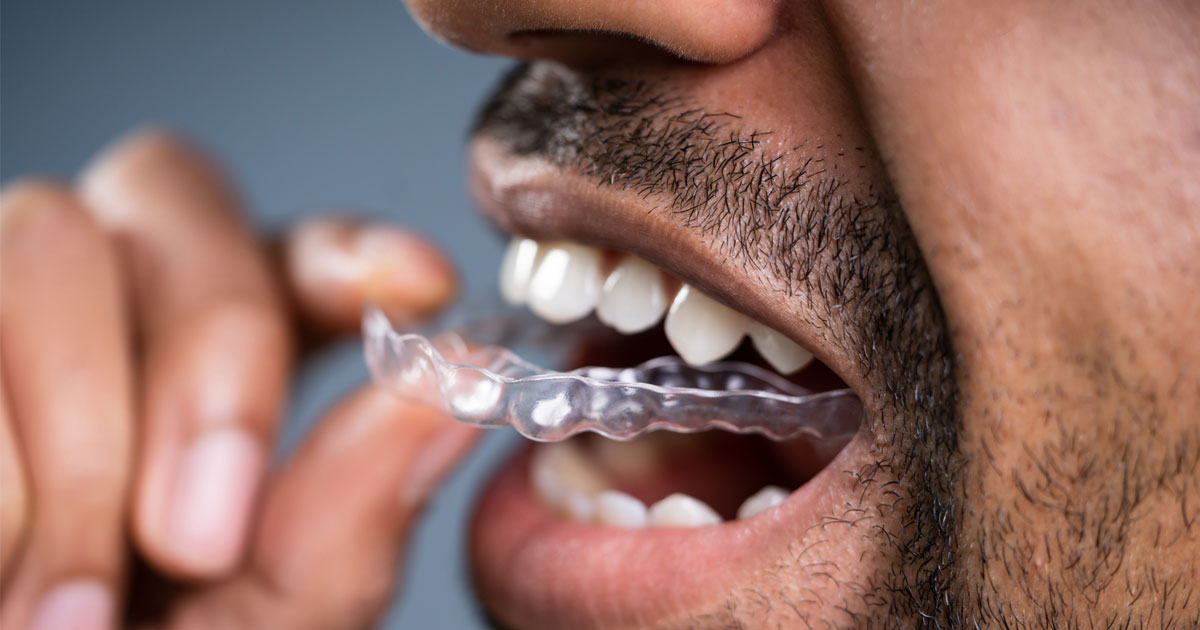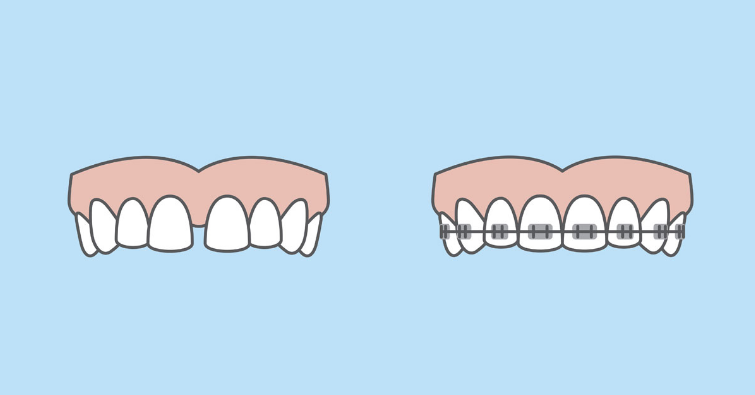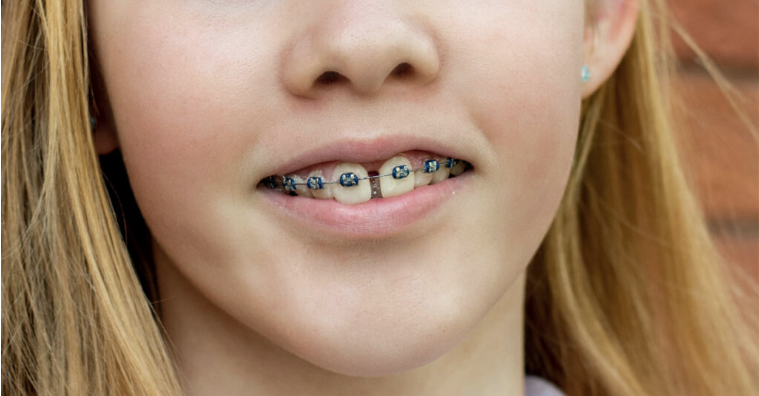Can braces fix gaps in teeth? While it may seem like we’re surrounded by images of celebrities with gleaming smiles, most of us aren’t born with perfect teeth. There are many common issues that can arise involving improper alignment, such as overbites, underbites, crooked teeth, and more. One of the more common issues that can be caused by alignment issues is the tooth gap. While many children and adults alike have gaps between their teeth, it’s an issue many prefer to fix with orthodontics.
How Can Braces Fix Gaps in Teeth?
Braces are the primary orthodontic device used to fix all kinds of alignment issues other forms of treatment can’t, and this does include gaps in the teeth. So, what does the procedure entail? Is there pain or discomfort involved? Most importantly, can the gap be closed permanently or will it require continuous treatment and equipment?
How Long Does It Take to Close a Tooth Gap With Braces?
In theory, addressing a gap with braces is a fairly simple procedure. You’ll need to attend an appointment with an orthodontist, who will devise a treatment plan for your unique situation. Then, you’ll schedule a second visit, and the orthodontist will most likely place spacers to give your teeth more room for the braces. Over the next two or more visits, brackets and bands will be placed to begin moving your teeth.
Once your braces are in place, expect to wear them for at least six months—though most people wear them longer. Typically, people need to wear their braces for a year or two before their teeth are properly straightened, but it’s not possible to stay exactly how long you’ll need to wear them without an examination. For example, someone with a severe gap or multiple gaps will often need to wear braces a bit longer than someone with a minor gap. If your tooth gap is part of a bigger dental problem, the braces will need to stay on until all problems are resolved, even if the gap is closed.

Rest assured: it should not take years to address an average tooth gap with braces. If you’re still concerned braces may take too long, or if you’re an adult who wants a more subtle fix, Invisalign aligners can be a great option.
Does It Hurt to Fix a Gap With Braces?
Braces are, unfortunately, rather infamous for being uncomfortable. Fortunately, while it’s true that many people experience some discomfort after their braces are affixed, most report feeling back to normal after a short time. The process of closing the gap shouldn’t be any more painful than other orthodontic procedures.
Consider, too, that in the long run, closing a gap can actually prevent more damage and pain. For example, a gap can make it easier to damage your gums due to the increased exposure. In addition, misaligned teeth can lead to cavities, painful bite, and other issues. In this way, addressing misalignments and gaps can prevent pain in the future.
“You can have the smile you’ve always wanted by opting for braces to fix these issues in your teeth.”
Will The Gap Be Closed Permanently?
Can braces fix gaps in teeth permanently? If you’re looking to address a natural gap in your teeth, you’re likely wondering whether treatment with braces will take care of the problem forever, or just for as long as the braces stay on. After all, you don’t want to go through the realignment process just for your teeth to shift back to the way they were before. This is especially true if you are experiencing alignment issues that have the potential to affect your oral health.

Braces are designed to realign your teeth and keep them in position for as long as they are affixed. After your braces are removed, you’ll likely need to take additional steps to keep your teeth trained to remain in their new position, rather than the position they naturally assumed. Retainers are typically utilized to keep your teeth aligned for as long as possible, and your orthodontist may instruct you to wear one during the day, at night, or both, depending on your unique situation.
More specialized treatment can be provided if the gap isn’t responsive to braces and retainers alone. For example, the orthodontist might consider using a procedure known as dental bonding to keep the gap closed indefinitely. If you’re concerned about the likelihood of your natural gap returning, talk to your orthodontist to discuss other treatment options or ways you can ensure the braces process works long-term.
What If a Tooth Gap Isn’t Naturally Occurring?
In most cases, a tooth gap occurs as the result of your natural mouth structure, tooth size, or a large labial frenum (the skin connecting your top lip to your front teeth). When these gaps occur between the front teeth, they are known as diastema, and are the result of your unique genetics. However, that doesn’t mean every tooth gap is caused by natural occurrences.
For example, teeth can be knocked out via oral injury or removed due to advanced tooth decay. Some habits can cause gaps as well. A child who sucks their thumb constantly for years on end may pull the teeth forward a little bit at a time, which can create gaps. The same can occur if a person swallows by pushing against the front teeth.
Fortunately, the cause of the gap usually doesn’t determine whether braces will be effective. It may just alter specifics of the treatment plan, including whether other work needs to take place. It’s important to remember that while braces can close a gap caused by bad habits or tooth loss, they won’t fix the original problem—behavioral changes or a dental prosthetic may be needed to prevent the issue from recurring.
How Much Will It Cost to Close a Tooth Gap?
As with most oral issues, the cost of treatment will depend on your unique situation and the treatment plan you develop with your orthodontist.
There are a few factors that can affect the overall cost of closing a tooth gap:
- The repairs needed, and how complex the treatment will be. Fixing a tooth gap alone is often easier and less expensive than fixing a tooth gap paired with an overbite and other crooked teeth, for example.
- Your insurance plan. Having all or even some of the cost covered by a dental insurance plan will, of course, make the overall procedure more affordable for you.
- The style of braces involved. There are several different kinds of braces that can address tooth gaps, including traditional metal braces, lingual braces, ceramic braces, and even Invisalign, and all come at different price points.
Fixing a simple tooth gap shouldn’t break the bank, so consult with your orthodontist to discuss the repair options and payment types available to you.

Should I Close My Tooth Gap?
Getting your gap closed is entirely up to you, but you’ll probably want to go through the process if you are experiencing one of the following issues.
Insecurity
Having your gap closed is important if you’re experiencing any sort of insecurity or discomfort involving your appearance. You should never have to feel self-conscious about your smile. If you do, getting your teeth fixed is a worthwhile investment.
Pain
If you’re experiencing gum pain or other problems caused by the tooth gap, consider getting it fixed. While many gaps are purely aesthetic, that doesn’t mean others can’t lead to oral issues. If your gums hurt, if you’re noticing other problems with tooth alignment, or if you’re having trouble flossing, brushing, or eating, then addressing your gap is important.
External Sources
You will likely need to close your tooth gap if it was caused by an external source. Gaps resulting from poor habits or injury can especially benefit from the use of braces to prevent further issues.
Your Orthodontist’s Advice
Even if you’re not bothered by your gap, you should consider closing it if your orthodontist identifies a potential issue. Your orthodontist is there to make sure your teeth are healthy and aligned properly. If they determine that your gap can lead to bigger problems down the line, addressing it now can prevent a more expensive fix later.
Are There Better Orthodontic Options Besides Braces?
While traditional braces are an excellent way to close a tooth gap, you may experience even more benefits from other types of orthodontic procedures. For example, not all treatment options suit everyone, and many people prefer to avoid braces for aesthetic reasons. While there is certainly nothing wrong with wearing braces, it’s important to know that there are other options that can address your gap just as effectively.
Some of these other options include the Invisalign system, a series of clear plastic aligner trays developed especially for your mouth. Invisalign can address gaps both covertly and efficiently. Lingual braces are affixed to the inside surface of the teeth, and address gaps the same way as traditional braces but much more discreetly. Finally, ceramic braces work the same way as traditional braces, but utilize a tooth-colored ceramic bracket instead of the traditional metal. Ask your orthodontist which option may be right for you.

Can Braces Fix Gaps in Your Teeth? – Yes!
To put it simply, braces close gaps by slowly putting pressure on the teeth, using metal brackets connected by wires or bands. This pressure moves the teeth together and into their proper alignment. However, the process of addressing a tooth gap with braces can be a bit different for everyone. You can have the smile you’ve always wanted by opting for braces to fix these issues in your teeth. At Robison Orthodontics, we’ll be able to give you a consultation and help recommend the best plan of action based on your individual needs. You deserve to have a smile you love—and we would love to help you get there.
Give us a call and read our blog for more information!
*Editor’s Note: This article was originally published March 10, 2020 and has been updated November 4, 2022.

Dr. Tyler Robison is an alum of Mesa’s Mountain View High School. He graduated from Brigham Young University before being accepted to the “Top Ten-nationally ranked” University of Louisville in Kentucky, where he earned his Doctorate in Dental Medicine and a Master’s Degree in Oral Biology. He graduated with honors in the top ten percent of his class. Dr. Robison continued at the University of the Pacific in San Francisco, where he received a second master’s degree in dental science and his orthodontic certification.


